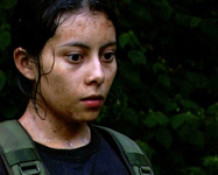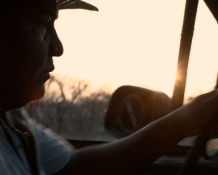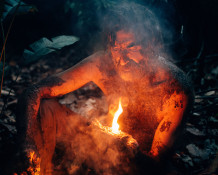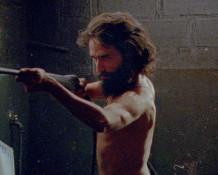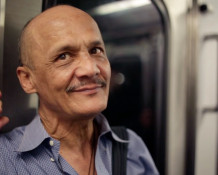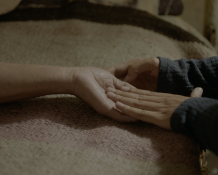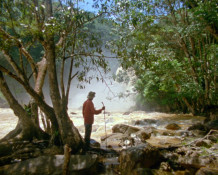Corta
|
Un film de Felipe Guerrero Producción Co producción Director Productores Productores Ejecutivos Corteros Fotografía Cámara Registro de sonido Montaje de sonido Mezcla Música Con la ayuda de
|
 |
|||
|
At first the sugar cane field looks like a huge green wall, a wall that will take the workers days to overcome. The sugar cane cutters begin their day by sharpening their machetes before they start to work. Blow by blow. The camera keeps its distance as it observes their smooth movements. Soon every sense of time is lost, the sugar cane cutters’ rhythmic movements develop their own choreography, and time seems to expand. The more sugar cane they cut the brighter the screen. The sky, the hill and the green landscape surrounding the field emerge. This flow is interrupted by a black screen like the end of a reel. Then the process begins again. The rhythm of the machetes and the workers’ steps on the dry leaves merge with the conceptual music of this film. Felipe Guerrero refrains from any sociological discourse about the cutters’ situation and working conditions. It’s the abstraction that brings out the exploitative element of this archaic labour all the more clearly. (Paulo de Carvalho) CORTA, el documental de Felipe Guerrero, es al mismo tiempo una película sobre el trabajo, el cuerpo y sobre la propia materialidad del cine. Lo más evidente y expuesto en el film son los cuerpos de los corteros de caña de azúcar del Valle del Cauca, y el esfuerzo que emplean en sus faenas diarias. Al “mostrar” el trabajo físico, las oscilaciones entre gasto de energía y reposo, entre preparación y labor, entre espera y tarea efectiva, CORTA reivindica la santidad laica del trabajo, en un país que se avergüenza de la labor material y que ha construido una galería de héroes pensantes y melancólicos, o de antihéroes que ordenan lo que otros deben ejecutar. Pero la sutil banda sonora del film, con sus otros niveles de narración, nos habla de más cuerpos (los cuerpos deseados de las canciones que se escuchan en la radio, con sus connotaciones sexuales; el cuerpo de Raúl Reyes, deseado como un trofeo de guerra del conflicto colombiano; el territorio como objeto de deseo de la libido capitalista). Una dinámica de los cuerpos, envueltos por el paisaje sonoro que ellos mismos propician al momento de realizar su trabajo. CORTA es eso, y a su vez un estudio sobre la propia dinámica del corte cinematográfico, que utiliza como anclaje y soporte el trabajo de corte de caña de azúcar en Colombia. Una labor basada en la reiteración del esfuerzo físico, el cual Felipe Guerrero emparenta con la búsqueda de generar ese trance, ese estado cuasi hipnótico de los trabajadores en el propio espectador. CORTA es una experiencia cinematográfica pura, que remite al cine primitivo a sus primeras representaciones y a aquellos lugares que captó en sus primeras vistas, estableciendo así como algunas formas de explotación siguen existiendo pese al paso de un siglo. CORTA is the dynamic of bodies involved in the sound landscape they generate when carrying out their work. It is also a study of the dynamics of film as a medium, using the labor of cutting sugar cane in Colombia as its anchor and support. A labor that is based in the repetition of physical exertion, which Felipe Guerrero relates to the attempt of generating the workers’ trance, this quasi-hypnotic state, in the audience. CORTA is a pure cinematographic experience that borrows from cinema’s initial representations and those places it captured its first vistas, establishing how some methods of exploitation continue to exist despite the passage of a century. (Raul Camargo) The process of harvesting sugar cane in Valle del Cauca in Columbia is exhausting and redundant. At the same time, the film CORTA shows subtle musical beauty, which is the aesthetic source of the film. Having rich experience of editing many films, director Felipe Guerrero lays stress on long-take as cinematic rhythm in his works. In the rough harvesting process, workers sharpen blades, cut sugar canes, and set fire in the fields after harvest, and this signifies the similarly detailed process of filmmaking. Enraptured by the solid monotonousness in the site portrayed by fixed cameras, the audience will harvest the sweetness of rich perception from the rough images. What the director presents to us through the hard work of the workers is pure cinematic experience. The aspects of meditation created by the cinematic manifestation of material and time transcends the frame of time and space demarcated and limited by filming, guiding us to the dreamlike extra-sensory realm. In this film, the gap between documentary and poetry is not wide at all. (Seo Hyun-suk) La repetición forma parte de la esencia del cine: la constante reiteración de fotograma tras fotograma es la que hace posible esa ilusión de movimiento. Por eso no resulta arbitrario que para su segundo film Felipe Guerrero haya elegido rodar en 16mm, un soporte en vías de extinción, al igual que la tarea que registra. En este último caso la repetición es sólo aparente: a lo largo de una serie de rollos, el registro de un grupo de trabajadores en una cosecha de caña de azúcar en la selva colombiana adquiere con cada capa de imágenes, con cada nuevo inicio, dimensiones extraordinarias. Cine estructuralista en su mejor forma, aquel que, como definía P. Adams Sitney, “resalta su configuración formal y cualquier contenido narrativo es mínimo y subsidiario a su estructura”. En este caso, descansando buena parte de la narración en una precisa banda de sonido. CORTA demuestra que con esas armas y cruzando a Leon Hirszman con Sharon Lockhart, y a ésta con Sísifo, es posible lograr emociones sinceras y atrapar al espectador en una dulce hipnosis cinematográfica.(BAFICI) Desiccated, browned canes are interspersed with verdant new growth-the dogged proliferation of tropical vegetation fills the frame. A man appears. This nameless man, a worker, wears galoshes, a wide-brimmed hat, and carries some work equipment and his lunch. He sets down his things, prepares himself, and then begins to cut the cane with his machete. The scene ends when the roll of film runs out. Black leader is bookended by flash frames, and the next shot begins. Again, tall canes fill the frame, yet this time, a man is already in the shot with his back to us. He stands motionless for a moment (what feels almost like a performative pause), and then begins to ready himself for work. This formula repeats, with variations in each scene, and a gradual progression reveals the entire process of sugar cane harvesting-from hand-cutting, to the appearance of industrial farm machinery that rolls toward the camera in tank-like fashion, grabbing and dumping the cane into bins, which are then loaded into shipping containers and driven away by semis. The field is then burned, raked, and the whole process begins again. If this were a film simply about duration and endurance, it would have been shot on video and the entire film would have been one long take of men cutting cane. If this were a film just about labour, we would have seen them constantly cutting cane and being ‘productive’. Rather than beginning shots with the workers mid-work, in CORTA we are often made to witness the preparations, and the rituals of work instead of the work itself-clearly displayed accoutrement, the putting on and taking off of bandanas and hats, suiting-up and getting into character. Almost equal time is spent showing them sharpening their machetes, eating lunch under a makeshift tent, and changing out of work clothes into street clothes on a mound of cut cane. We are made to witness the human rhythms of work and non-work within a structure of production. We hardly see faces. Specificity of person or place is not being explored; it is anonymous and abstracted into labor and laborer. This is neither an anthropological, nor voyeuristic gaze; rather, we are witnessing an invisible system, the system of industry that has been remotely imposed, outsourced to far-off lands, on to nameless, faceless people. And as arcane as this globalized system of production is, just as abstrusely, these images have travelled across the world onto our screens, and similarly, the product of their labor, sugar, appears discreetly on our tables. Duration in CORTA has as much to do with the audience, as it does these laborers. It translates their rhythm of work and repetition into cinematic terms, into short vignettes, with lengths determined by the film stock. We are made to witness the worker’s Debordian confinement within pseudocyclical industrial time, while simultaneously subject to a cyclical cinematic structure that both mimics, and is experientially distinct from theirs. The worker’s immobility within this system of commodified time is linked to that of the viewer within the imposed linear cinematic structure which ends just as it began. The use of music in CORTA points to necessary loopholes, and ambiguous spaces outside of this system. The same percussive, metallic drumming that the film commences with, returns throughout the film over the leader between scenes. This music contrasts the diegetic confinement within the images and liberates the viewer into a purely cinematic space, while only ambient noise, and sometimes the radio, is heard within the scenes. The intentionality, with which one of the labourers turns on his radio, pointedly signifies a distinctly proletariat sound, in contrast to the abstract percussive tracks, audible only to us. An exception to this delineation is the wistful song of one of the workers, which floats in and out of one scene. It is unclear who is singing, but we know why the caged bird sings. (Aily Nash) |
IFFR FICCI BAFICI JIFF Jeonju DISTRITAL LIMA INDEPENDIENTE FIDOCS SPLIT GARAGE, Center for Contemporary Culture TTFF DOK LEIPZIG BIM FICCALI RIPBM Festival del Nuevo Cine Latinoamericano BABYLON DOKFILMWOCHE LACLEF LIMA INDEPENDIENTE RIPBM MARGENES ALUCINE EDOC MAMBA CINE TONALA |



